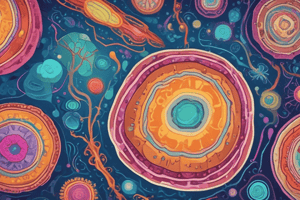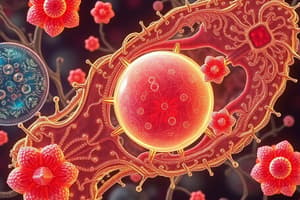Podcast
Questions and Answers
What is the primary function of the nucleus in a eukaryotic cell?
What is the primary function of the nucleus in a eukaryotic cell?
- Energy production
- DNA storage and control of cell activities (correct)
- Protein modification
- Lipid synthesis
Which of the following organelles is involved in the synthesis of lipids?
Which of the following organelles is involved in the synthesis of lipids?
- Smooth endoplasmic reticulum (correct)
- Golgi apparatus
- Rough endoplasmic reticulum
- Lysosomes
What type of cell organelle is the Golgi apparatus?
What type of cell organelle is the Golgi apparatus?
- Ribosome assembly area
- Organelle that produces ATP
- Site of photosynthesis
- Membrane-bound structure for protein and lipid modification (correct)
What role do ribosomes play in a eukaryotic cell?
What role do ribosomes play in a eukaryotic cell?
What structure within the nucleus is specifically responsible for ribosome production?
What structure within the nucleus is specifically responsible for ribosome production?
What is the primary purpose of lysosomes in a eukaryotic cell?
What is the primary purpose of lysosomes in a eukaryotic cell?
Which organelle is known as the powerhouse of the cell?
Which organelle is known as the powerhouse of the cell?
What is the main function of chloroplasts in eukaryotic cells?
What is the main function of chloroplasts in eukaryotic cells?
What is a primary disadvantage of using a Transmission Electron Microscope (TEM)?
What is a primary disadvantage of using a Transmission Electron Microscope (TEM)?
How does the maximum magnification of a Scanning Electron Microscope (SEM) compare to that of a TEM?
How does the maximum magnification of a Scanning Electron Microscope (SEM) compare to that of a TEM?
Which of the following correctly defines magnification?
Which of the following correctly defines magnification?
What is necessary before using the eyepiece graticule to measure a specimen?
What is necessary before using the eyepiece graticule to measure a specimen?
What is a significant feature of the images produced by a Scanning Electron Microscope (SEM)?
What is a significant feature of the images produced by a Scanning Electron Microscope (SEM)?
What step is essential when preparing a specimen for viewing with an optical microscope?
What step is essential when preparing a specimen for viewing with an optical microscope?
What is the maximum resolution of a TEM?
What is the maximum resolution of a TEM?
Which process is used to determine the size of a specimen under a microscope?
Which process is used to determine the size of a specimen under a microscope?
What basic function do both TEM and SEM share?
What basic function do both TEM and SEM share?
In the calculation of magnification, what initial step is necessary?
In the calculation of magnification, what initial step is necessary?
What is the primary function of the plasma membrane?
What is the primary function of the plasma membrane?
Which structure is not found in plant and bacterial cells?
Which structure is not found in plant and bacterial cells?
What is the composition of prokaryotic ribosomes compared to eukaryotic ribosomes?
What is the composition of prokaryotic ribosomes compared to eukaryotic ribosomes?
Which of the following cells utilize cilia for movement?
Which of the following cells utilize cilia for movement?
What role do pili serve in prokaryotic cells?
What role do pili serve in prokaryotic cells?
What is the function of a vacuole in plant cells?
What is the function of a vacuole in plant cells?
What is one distinctive feature of eukaryotic cells compared to prokaryotic cells?
What is one distinctive feature of eukaryotic cells compared to prokaryotic cells?
Which microscope can visualize living cells in real-time?
Which microscope can visualize living cells in real-time?
What does the Golgi apparatus primarily do with proteins?
What does the Golgi apparatus primarily do with proteins?
What material makes up plant cell walls?
What material makes up plant cell walls?
Which statement about flagella in eukaryotic cells is true?
Which statement about flagella in eukaryotic cells is true?
What is a characteristic feature of plasmids in prokaryotic cells?
What is a characteristic feature of plasmids in prokaryotic cells?
What aspect distinguishes the transmission electron microscope (TEM) from light microscopes?
What aspect distinguishes the transmission electron microscope (TEM) from light microscopes?
Cytoskeleton's primary role in the cell includes which of the following?
Cytoskeleton's primary role in the cell includes which of the following?
Flashcards
What is the nuclear envelope?
What is the nuclear envelope?
A double membrane that surrounds the nucleus, containing pores that allow small molecules to pass into the cytoplasm while keeping chromosomes inside.
What is the nucleolus?
What is the nucleolus?
A region within the nucleus where ribosomes are assembled.
What is the rough endoplasmic reticulum (RER)?
What is the rough endoplasmic reticulum (RER)?
It's an extension of the nuclear envelope that facilitates protein synthesis by providing a large surface area for ribosomes.
What is the smooth endoplasmic reticulum (SER)?
What is the smooth endoplasmic reticulum (SER)?
Signup and view all the flashcards
What is the Golgi apparatus?
What is the Golgi apparatus?
Signup and view all the flashcards
What is the mitochondria?
What is the mitochondria?
Signup and view all the flashcards
What is a lysosome?
What is a lysosome?
Signup and view all the flashcards
What is the chloroplast?
What is the chloroplast?
Signup and view all the flashcards
Cell Wall
Cell Wall
Signup and view all the flashcards
Plasma Membrane
Plasma Membrane
Signup and view all the flashcards
Centrioles
Centrioles
Signup and view all the flashcards
Flagella
Flagella
Signup and view all the flashcards
Cilia
Cilia
Signup and view all the flashcards
Vacuole
Vacuole
Signup and view all the flashcards
Translation (Protein Production)
Translation (Protein Production)
Signup and view all the flashcards
Cytoskeleton
Cytoskeleton
Signup and view all the flashcards
Prokaryotes
Prokaryotes
Signup and view all the flashcards
Eukaryotes
Eukaryotes
Signup and view all the flashcards
Plasmids
Plasmids
Signup and view all the flashcards
Pili
Pili
Signup and view all the flashcards
Mesosomes
Mesosomes
Signup and view all the flashcards
Slime Capsule
Slime Capsule
Signup and view all the flashcards
Confocal Microscope
Confocal Microscope
Signup and view all the flashcards
What is a Transmission Electron Microscope (TEM)?
What is a Transmission Electron Microscope (TEM)?
Signup and view all the flashcards
What is a Scanning Electron Microscope (SEM)?
What is a Scanning Electron Microscope (SEM)?
Signup and view all the flashcards
What is resolution?
What is resolution?
Signup and view all the flashcards
What is magnification?
What is magnification?
Signup and view all the flashcards
What are the eyepiece graticule and stage micrometer?
What are the eyepiece graticule and stage micrometer?
Signup and view all the flashcards
What is calibrating the eyepiece graticule?
What is calibrating the eyepiece graticule?
Signup and view all the flashcards
What is eosin?
What is eosin?
Signup and view all the flashcards
What is the coarse adjustment knob?
What is the coarse adjustment knob?
Signup and view all the flashcards
What is a specimen used for viewing under a microscope?
What is a specimen used for viewing under a microscope?
Signup and view all the flashcards
What is a coverslip?
What is a coverslip?
Signup and view all the flashcards
Study Notes
Cell Structure and Function
- Organisms are categorized into eukaryotes and prokaryotes.
- Eukaryotic cells contain a nucleus and membrane-bound organelles.
- Prokaryotic cells lack a nucleus and membrane-bound organelles.
Eukaryotic Organelles
- Nucleus: Contains DNA (genetic instructions) associated with histone proteins (chromatin). Wound into chromosomes.
- Nucleolus: Site of ribosome production.
- Nuclear Envelope: Double membrane surrounding the nucleus; contains pores for small molecule passage.
- Rough Endoplasmic Reticulum (RER): Extension of nuclear envelope, studded with ribosomes; facilitates protein synthesis and transport to Golgi.
- Smooth Endoplasmic Reticulum (SER): Synthesizes lipids (cholesterol, hormones).
- Golgi Apparatus: Modifies and packages proteins and lipids from RER and SER into vesicles. Site of lysosome synthesis.
- Ribosomes: Synthesize proteins; can be free-floating or bound to RER.
- Mitochondria: Site of ATP production (aerobic respiration); self-replicating, numerous in high energy cells. Contains cristae (folds) for increased surface area.
- Lysosomes: Contain digestive enzymes; destroy old organelles or foreign material.
- Chloroplasts: Site of photosynthesis; found only in plants/photosynthetic organisms. Double membrane; thylakoid membranes (grana, lamellae).
- Plasma Membrane: Phospholipid bilayer with proteins (carriers) and cholesterol; controls substance movement. Maintains cell contents.
- Centrioles: Bundles of microtubules; form spindle fibers during mitosis (cell division); important for cilia and flagella formation; absent in plant cells.
- Cell Wall: Rigid structure; made of cellulose (plants), chitin (fungi), or murein (prokaryotes). Provides structural support to the cell.
- Flagella: Tail-like structure made of microtubules; propel cells; found in sperm cells.
- Cilia: Finger-like projections; made of microtubules; used for movement (e.g., in trachea, moving mucus).
- Vacuole: Organelle that stores cell sap, nutrients, and proteins; maintains turgor pressure in plant cells; can also digest large molecules.
Protein Synthesis Pathway
- Ribosomes translate mRNA into polypeptides or proteins.
- Polypeptides fold in RER and are transported to the Golgi in vesicles.
- Golgi modifies proteins, adds carbohydrate chains/sulfates/phosphates, and packages them.
- Vesicles deliver proteins to needed locations (e.g. plasma membrane).
Cytoskeleton
- Network of protein filaments (microfilaments and microtubules) through cytoplasm.
- Supports organelles, maintains cell shape, and facilitates movement of organelles and chromosomes, cilia and flagella.
Prokaryotic vs. Eukaryotic Cells
- Prokaryotes lack membrane-bound organelles; DNA is free-floating, circular chromosomes, have smaller ribosomes.
- Prokaryotes have cell walls (murein), can have flagella (made of flagellin).
- Prokaryotic unique structures include pili, mesosomes, plasmids, and slime capsules.
Microscopy Techniques
- Light Microscope: Magnification up to 1500x; resolution ~0.2 µm; can observe living cells.
- Confocal Microscope: Advanced light microscope; uses lasers to provide clearer 3D images of labelled specimens.
- Transmission Electron Microscope (TEM): High resolution (~0.0002 µm); visualizes organelles; sample must be fixed and placed in vacuum.
- Scanning Electron Microscope (SEM): Lower resolution (~0.002 µm); produces 3D images; sample must be fixed and placed in vacuum.
Measuring Specimen Size
- Using eyepiece graticule and stage micrometer, calculate magnification or the size of objects.
- Aligning graticule with micrometer allows for determining actual size.
Viewing Specimens
- Preparing slides with water, specimen, stain, cover slip.
- Using lowest-powered objective lens followed by increasing magnification for visualization.
Studying That Suits You
Use AI to generate personalized quizzes and flashcards to suit your learning preferences.




